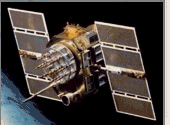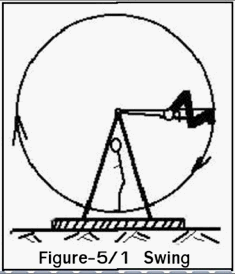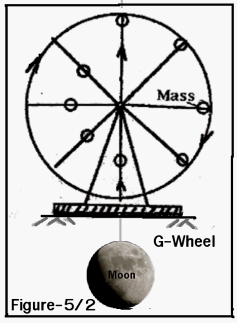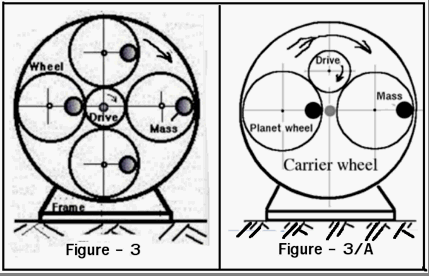
Franz Heeke - Muenster, Germany
It is being proposed to carry out
experiments with "swing effects" in controlling
orbits or trajectories of spacecraft.
My publication "Shaker effects in celestial mechanics"
describes angular momentum exchange in celestial systems. That
article may provide some supplementary information to following
statements and ideas (article1).
Exchange
of angular momentum in celestial systems is basically well known:
-
The rotation of earth is slowing down (tidal braking) and our moon's
orbit is widening. There is a transfer of angular momentum from earth
to moon.
- The orbit of Mars- moon Phobos, on the other hand, is
contracting. Mars' rotation is speeding up (tidal drag). There is a
transfer of angular momentum from Phobos to Mars.
- Man made
spacecraft can pick up angular momentum from planets in
"gravitational slingshot-" or "swing-by-"
"maneuvers. A transfer of angular momentum takes place from
planet to the spacecraft.
All these phenomena are related or
equivalent to the effects observed in a swing.
The underlying idea of the proposed experiments is, to achieve a widening of spacecraft- orbits (as in case of earth- moon) or a contracting of spacecraft- orbits (as in case of Phobos- Mars) with a piece of on-board technical equipment. The working of this technical equipment would be based on the principle of a swing.

Figure-5/1 shows a swing system The rotation is being driven by lifting the body mass against earth's gravitation at the lowest point.
This swing system
obviously can be replaced by a "gravitation wheel"
(G-Wheel) with a number of movable masses on spokes, as shown in
Figure-5/2. In that way a more smoother rotation is being achieved.
The movable masses in this G-Wheel are being lifted up against
gravitational forces, whenever in vertical position. The center of
mass of the wheel thus is always outside of its axis of rotation.
Gravitation then produces a rotation, which will accelerate, as long
as the input of energy goes on (friction neglected). How the required
energy comes in, can be left open at this stage.

My understanding of physical laws involved is, that this G-Wheel is "heavier than at rest" as long as its rotation is being accelerated. Einstein's principle of equivalence applies, according to his famous (Gedanken-) elevator experiment. We all feel "heavier" in an upward accelerating elevator (to the contrary when accelerating downward). The individual masses in shown G-Wheel are continuously being accelerated upward. The difference to an elevator is, that the upward- acceleration here changes to an acceleration of rotation.
The individual masses of
the G-Wheel obviously can be lifted up as well against earth's
gravitation as against the gravitation of a distant moon
(Figure-5/2). There is no difference in principle.
The rotating G-Wheel now may be looked upon as a rotating
celestial body, like a planet. Its initial rotation will accelerate,
if operated as before. At same time a reaction force is being
generated toward the moon. The imaginary planet (G-Wheel) moves
closer to its moon, picking up angular momentum from it. Moon's orbit
is contracting, as in case of Phobos-Mars.
The rotation of
the imaginary planet (G-Wheel) in contrast will slow down and
decelerate, when rotating in opposite direction, to the left.
Individual masses on the spokes are being pushed down in that case,
towards the moon, when in upper and lower vertical position. The
imaginary planet (G-Wheel) then transfers energy and angular momentum
to its moon. Moon's orbit is widening, as in case of Earth-
Moon.
The eccentric moving of masses is being brought about in
real celestial systems by tidal forces. A tidal drag then may be
expected, when an eccentric mass (a tidal bulge) is moving and being
pulled in direction toward the moon, a tidal braking, when such an
eccentric mass (tidal bulge) is moving away from it. In case of
Figure-5/2: The rotation of the imaginary planet will accelerate, as
long as its center of mass is to the right of the line planet-moon,
its rotation would slow down and decelerate, if the center of mass
would be to the left of this line.
More than thirty years ago I developed a G-Wheel as shown in Figure-3 below. That wheel works in principle the same way as the one in Figure-5/2. Eccentric masses on small planetary wheels inside a big carrier wheel are continuously being lifted upward, driven and controlled by an internally placed (electric) drive, which can be placed in different positions.

The center of mass of the
carrier wheel (Figure-3) remains always outside of its axis of
rotation. Gravitation thus causes the carrier wheel to rotate and
accelerate in right direction. I demonstrated the functioning of this
G-Wheel with a simple prototype with two planet wheels (Figure 3/A)
at the patent office in Munich. My invention then was awarded the
German patent DE 2821 827 C2 on 30th June 1983 (meanwhile expired).
Starting with an initial rotational speed (the faster the
better) the carrier wheel may resemble an imaginary rotating planet
as described before. It is possible, according to my understanding,
to simulate "tidal drag" and "tidal braking" with
such a wheel on- board a spacecraft. The orbit or trajectory of the
spacecraft then will change. Some rough calculations are being put up
for discussion separately.
It proved to be impossible twenty
five years ago, to get a company or research institute interested in
financing further development of this invention. Most experts refused
to accept the underlying idea. They possibly still do so. However,
there can be no doubt, that some day a curious researcher will do the
required test work, to prove me either wrong or right. Thus, time
will show, what is all about. The described device, if working as
assumed, may save considerable expenditure in spacecraft control,
reducing fuel consumption and extending lifetime of satellites. Basic
verification tests, on the other hand, can be carried out with quite
limited funding. Proving, that the G-Wheel is indeed "heavier
than at rest" as long as its rotation is being accelerated,
should be possible with a rather simple wheel. More elaborate
experiments lateron then might help also in understanding
"gravitational waves" as predicted by Albert Einstein. He
predicted, that an accelerating mass produces changes in gravitation.
F. Heeke; Homepage
6-2009 (updated 4-2012)
Back to index